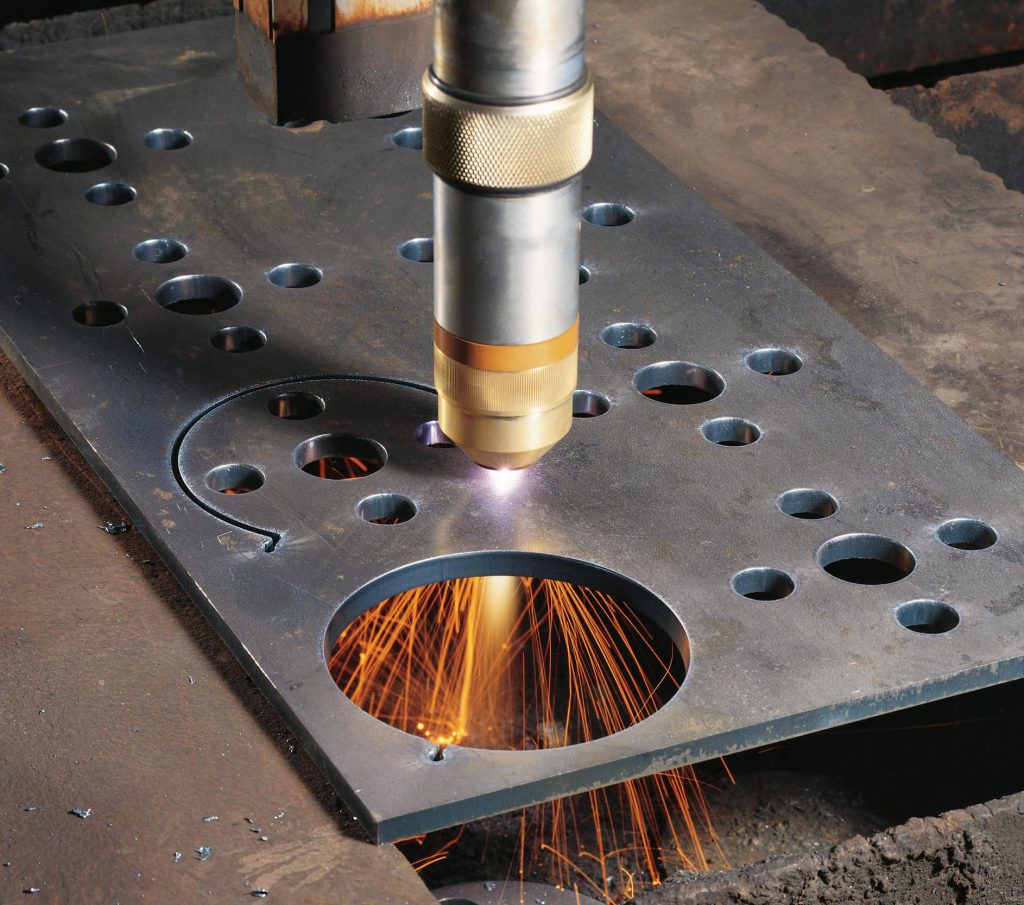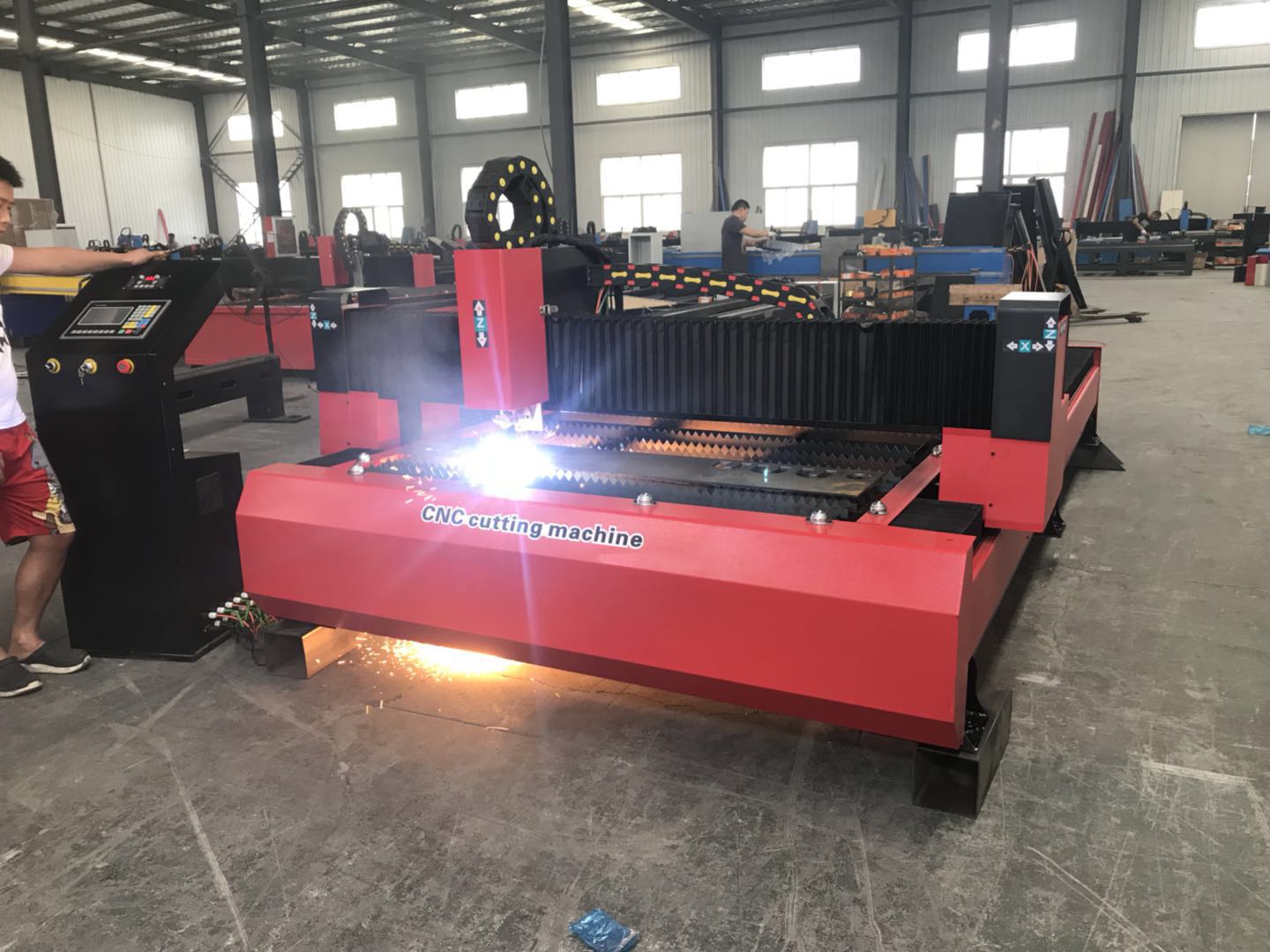Plasma is a gas that is heated to a very high temperature and is highly ionized. It transfers the arc power to the workpiece. The high heat melts the workpiece and is blown off, forming a working state of plasma arc cutting, and uses the momentum of the high-speed plasma to remove the molten metal. To form a processing method of incision.
Plasma cutting with different working gases can cut all kinds of metals that are difficult to cut by oxygen, especially for non-ferrous metals (stainless steel, aluminum, copper, titanium, nickel). The main advantage is that the thickness of the metal is not large. At the same time, plasma cutting speed is fast, especially when cutting ordinary carbon steel sheet, the speed can reach 5-6 times that of oxygen cutting method, the cutting surface is smooth, the thermal deformation is small, and there is almost no heat-affected zone! Plasma cutting machines are widely used in automobiles, locomotives, pressure vessels, chemical machinery, nuclear industry, general machinery, engineering machinery, steel structures and other industries.

Working principle process:
1. After the compressed air enters the cutting torch, it is distributed by the gas chamber to form plasma gas and auxiliary gas. The plasma gas arc serves to melt the metal, while the auxiliary gas cools the various parts of the torch and blows off the molten metal.
2. The cutting power supply consists of two parts: the main circuit and the control circuit. The electrical principle: the main circuit includes a contactor, a three-phase power transformer with high leakage reactance, a three-phase bridge rectifier, a high-frequency arc ignition coil and a protection element. The high leakage reactance leads to a sharp external characteristic of the power supply. The control circuit completes the entire cutting process through the button switch on the cutting torch: pre-venting-main circuit power supply-high-frequency arc ignition-cutting process-arc recovery-stop
three,
3. The power supply of the main circuit is controlled by the contactor; the gas flow is controlled by the solenoid valve; the control circuit controls the high-frequency oscillator to ignite the arc, and stops the high-frequency operation after the arc is established.

Plasma arc cutting process parameters:
Various plasma arc cutting process parameters directly affect the stability, cutting quality and effect of the cutting process. The main cutting specifications are briefly described as follows:
1. No-load voltage and arc column voltage
The plasma cutting power supply must have a high enough no-load voltage to easily start the arc and make the plasma arc burn stably. The no-load voltage is generally 120-600V, and the arc column voltage is generally half of the no-load voltage. Increasing the arc column voltage can significantly increase the power of the plasma arc, thereby increasing the cutting speed and cutting larger thickness metal plates. The arc column voltage is often not reached by adjusting the gas flow and increasing the internal shrinkage of the electrode, but the arc column voltage cannot exceed 65% of the no-load voltage, otherwise the plasma arc will be unstable.
The plasma cutting power supply must have a high enough no-load voltage to easily start the arc and make the plasma arc burn stably. The no-load voltage is generally 120-600V, and the arc column voltage is generally half of the no-load voltage. Increasing the arc column voltage can significantly increase the power of the plasma arc, thereby increasing the cutting speed and cutting larger thickness metal plates. The arc column voltage is often not reached by adjusting the gas flow and increasing the internal shrinkage of the electrode, but the arc column voltage cannot exceed 65% of the no-load voltage, otherwise the plasma arc will be unstable.
2. Cutting current
Increasing the cutting current can also increase the power of the plasma arc, but it is limited by the maximum allowable current, otherwise the plasma arc column will become thicker, the slit width will increase, and the electrode life will decrease.
Increasing the cutting current can also increase the power of the plasma arc, but it is limited by the maximum allowable current, otherwise the plasma arc column will become thicker, the slit width will increase, and the electrode life will decrease.
3. Gas flow
Increasing the gas flow can not only increase the arc column voltage, but also enhance the compression effect on the arc column, so that the plasma arc energy is more concentrated and the jet force is stronger, thus improving the cutting speed and quality. However, if the gas flow is too large, it will shorten the arc column, increase the heat loss, and weaken the cutting ability until the cutting process cannot be performed normally.
Increasing the gas flow can not only increase the arc column voltage, but also enhance the compression effect on the arc column, so that the plasma arc energy is more concentrated and the jet force is stronger, thus improving the cutting speed and quality. However, if the gas flow is too large, it will shorten the arc column, increase the heat loss, and weaken the cutting ability until the cutting process cannot be performed normally.
4. Electrode shrinkage
The so-called shrinkage refers to the distance between the electrode and the end surface of the cutting nozzle. A proper distance can make the arc be well compressed in the cutting nozzle, and obtain a plasma arc with concentrated energy and high temperature for effective cutting. If the distance is too large or too small, the electrode will be seriously burned, the cutting tip will be burnt out and the cutting ability will be reduced. The shrinkage is generally 8-11mm.
The so-called shrinkage refers to the distance between the electrode and the end surface of the cutting nozzle. A proper distance can make the arc be well compressed in the cutting nozzle, and obtain a plasma arc with concentrated energy and high temperature for effective cutting. If the distance is too large or too small, the electrode will be seriously burned, the cutting tip will be burnt out and the cutting ability will be reduced. The shrinkage is generally 8-11mm.
5. Cutting nozzle height
The height of the cutting nozzle refers to the distance from the end of the cutting nozzle to the surface of the workpiece to be cut. The distance is generally 4~10mm. It is the same as the internal shrinkage of the electrode, and the distance must be appropriate to give full play to the cutting efficiency of the plasma arc, otherwise the cutting efficiency and cutting quality will be reduced or the cutting nozzle will burn out.
The height of the cutting nozzle refers to the distance from the end of the cutting nozzle to the surface of the workpiece to be cut. The distance is generally 4~10mm. It is the same as the internal shrinkage of the electrode, and the distance must be appropriate to give full play to the cutting efficiency of the plasma arc, otherwise the cutting efficiency and cutting quality will be reduced or the cutting nozzle will burn out.
6. Cutting speed
The above various factors directly affect the compression effect of the plasma arc, that is, the temperature and energy density of the plasma arc. The high temperature and high energy of the plasma arc determine the cutting speed, so the above various factors are related to the cutting speed. On the premise of ensuring the cutting quality, the cutting speed should be increased as much as possible. This not only improves productivity, but also reduces the amount of deformation of the cut parts and the heat-affected area in the kerf area. If the cutting speed is not appropriate, the effect is opposite, and the sticking slag will increase and the cutting quality will decrease.
Post time:May-26-2021
